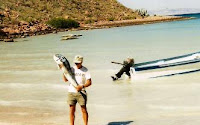Loafing on an Uninhabited
Island-----No Way
 In case you
think we sunned on the beach all day, think again. We did new and fun things
every day. Our homeport was the island of Espiritu Santo, in the Sea of Cortez. About 25 miles off the coast of La Paz, Mexico, it was a two and half hour
boat ride from the mainland. We camped on a lovely large sandy beach.
In case you
think we sunned on the beach all day, think again. We did new and fun things
every day. Our homeport was the island of Espiritu Santo, in the Sea of Cortez. About 25 miles off the coast of La Paz, Mexico, it was a two and half hour
boat ride from the mainland. We camped on a lovely large sandy beach.
Los
Islotes is a large barren rock island that is actually a bird rookery
and a roosting area for pelicans, blue footed
boobies, frigate birds, and terns. A
large colony of California sea lions also inhabit the island. The sea lions were so curious—they had a great time
circling around, over, and under us. They often got close enough to touch if
one’s reflexes were quick enough. They were all sizes and ages ranging in color
from a light tan to almost black. And all the while it was like swimming in an aquarium full of beautiful tropical
fish including large schools of sergeant majors and king angle fish. We also
saw several varieties of starfish, sea urchins, other sea animals and
coral. While we dried off in the boat we
watched sally light-foot crabs scampering across the rocks entertaining us.
We watched a huge school of dolphins playing at sea. We
walked and studied tidal pools. The islands exhibit a typical southern Sonoran
desert ecosystem, but the region is surprisingly rich in plant and animal
abundance and diversity.
We
hiked and had botany lessons on local plants. The Cardon cactus grew
everywhere. A relative to the Saguaro cactus, it has many more arms (up to 40)
which are more clustered at the base. Jojoba grew wild and has an interesting
history. The long nose bat pollinates it.
Evidence
of prehistoric Indian occupation is abundant throughout the larger islands. We
swam in a salt pond. Another day we made an excursion a couple of gorges over
and hiked inland about a quarter of a mile to a fresh-water well fully equipped
with bucket and rope. What a treat to be able to shampoo our hair!
At
dawn one morning a couple of fellows went fishing. Lucky for us they returned
with a 25 pound Dorado, known as Mahi Mahi in other parts of the world. It was fascinating
to watch the men fillet the fish. It was so quick! Sea gulls circled waiting
for the fellow to finish. Sure enough, as soon as the guide walked up to the
kitchen with the filets the gulls swooped in and in no time there was nothing
left on the beach but bones. They too were fast!
We
flew in and out of La Paz for a night on each end of the time spent on the
island. Even though we had had a wonderful time in the middle of nowhere, on
return it was wonderful to have a long
hot fresh water shower!


No comments:
Post a Comment